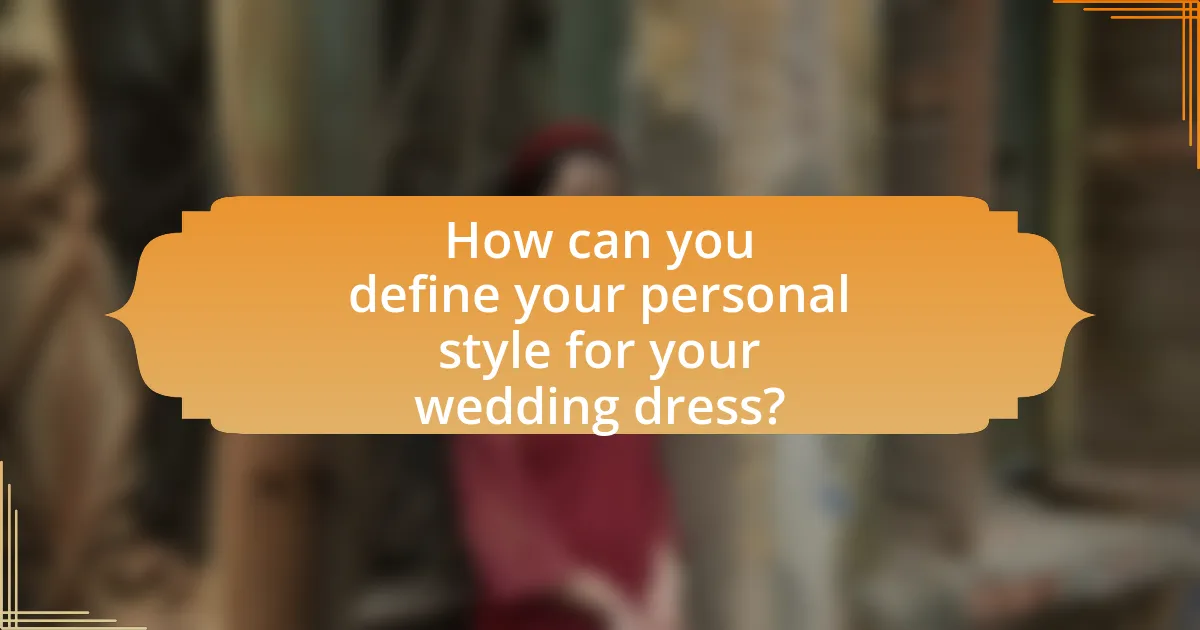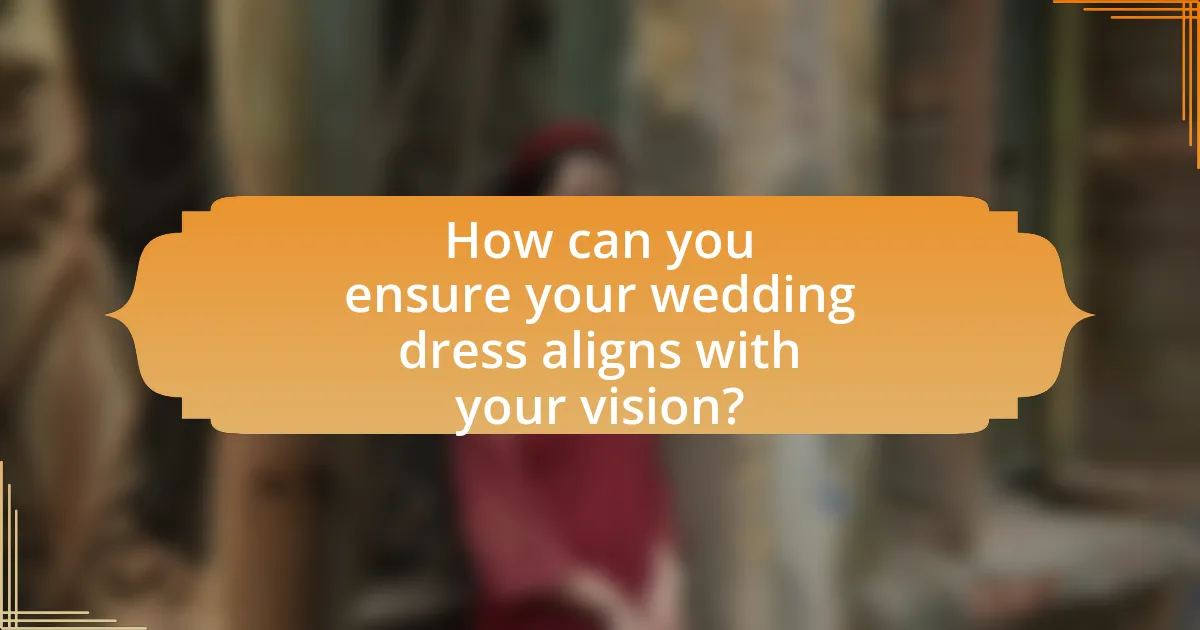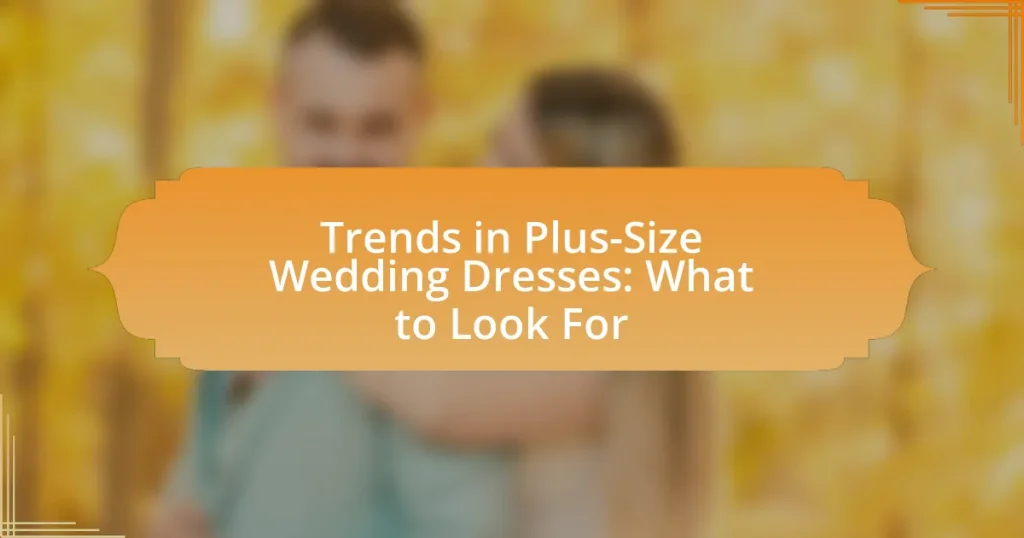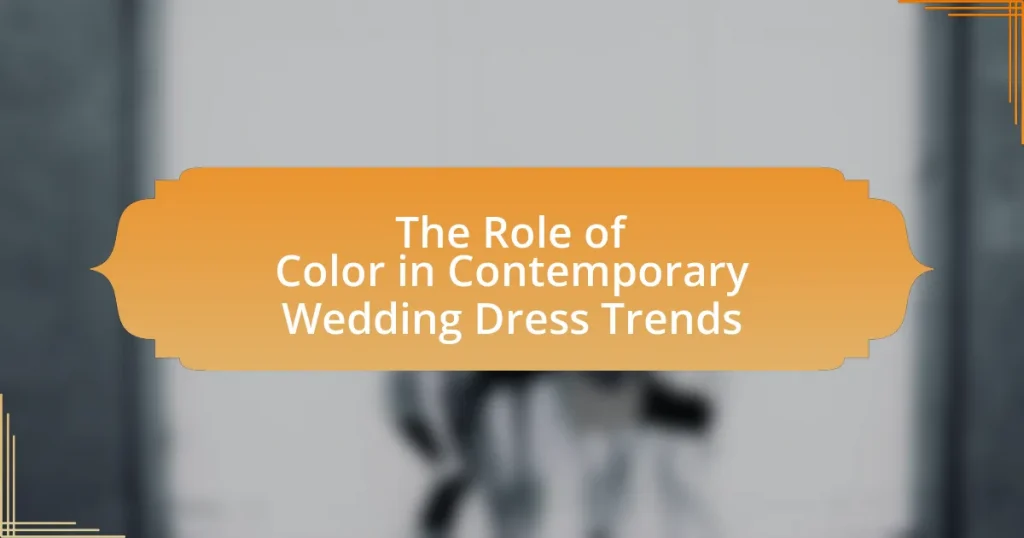The article focuses on how to incorporate personal style into wedding dresses, emphasizing the importance of defining aesthetic preferences such as classic, bohemian, modern, or vintage. It discusses key elements that contribute to personal style, including fabric choice, silhouette, color palette, and embellishments, while highlighting the significance of comfort and practicality. The article also explores customization options, alternative styles for non-traditional brides, and practical tips for ensuring the wedding dress aligns with individual vision and cultural backgrounds. Additionally, it addresses common mistakes to avoid and how to balance personal style with wedding themes and venues.

How can you define your personal style for your wedding dress?
To define your personal style for your wedding dress, start by identifying your aesthetic preferences, such as classic, bohemian, modern, or vintage. This foundational step allows you to narrow down design elements that resonate with you. For instance, if you prefer a bohemian style, you might choose flowing fabrics and floral details, while a modern aesthetic may lead you to opt for sleek lines and minimalistic designs.
Additionally, consider your lifestyle and comfort; a dress that reflects your everyday style will likely make you feel more at ease on your wedding day. Researching various dress styles and trying on different silhouettes can further clarify your preferences. According to a survey by The Knot, 45% of brides prioritize comfort in their wedding dress selection, indicating that personal style is often intertwined with practicality.
What elements contribute to personal style in wedding attire?
Personal style in wedding attire is influenced by factors such as fabric choice, silhouette, color palette, and embellishments. The selection of fabric, like lace or satin, can reflect individual taste and comfort, while the silhouette, whether A-line or mermaid, shapes the overall look and feel of the attire. Additionally, the color palette, ranging from traditional white to bold hues, allows for personal expression. Embellishments, including beading or embroidery, further enhance uniqueness and can signify personal significance or cultural heritage. These elements collectively contribute to a bride’s distinctive style, ensuring the attire resonates with her personality and vision for the wedding day.
How do color preferences influence your wedding dress choice?
Color preferences significantly influence wedding dress choices by guiding the selection of hues that resonate with the bride’s personal style and emotional connection to the event. For instance, brides who prefer classic aesthetics may gravitate towards traditional white or ivory dresses, while those with a penchant for boldness might choose vibrant colors like red or blue. Research indicates that color can evoke specific emotions; for example, white symbolizes purity and innocence, while red often represents love and passion. This emotional resonance can lead brides to select colors that reflect their personality and the atmosphere they wish to create on their wedding day.
What role do fabrics play in expressing personal style?
Fabrics play a crucial role in expressing personal style by influencing the overall aesthetic, comfort, and functionality of clothing. Different fabrics, such as silk, lace, or cotton, evoke distinct emotions and styles; for instance, silk conveys luxury and elegance, while cotton suggests casual comfort. The choice of fabric can reflect individual preferences and cultural backgrounds, allowing wearers to showcase their unique identities. Studies indicate that fabric texture and drape significantly affect how garments are perceived, reinforcing the idea that fabric selection is integral to personal expression in fashion.
Why is it important to incorporate personal style into your wedding dress?
Incorporating personal style into your wedding dress is important because it ensures that the dress reflects your individuality and personal taste. A wedding dress that aligns with your style enhances your confidence and comfort on a significant day, allowing you to express who you are. Studies show that personal expression in clothing can lead to increased self-esteem and satisfaction, which is crucial during such a pivotal life event. By choosing elements that resonate with your aesthetic, you create a memorable and authentic experience that resonates with both you and your guests.
How does personal style enhance your overall wedding experience?
Personal style enhances the overall wedding experience by allowing individuals to express their unique identity and preferences, creating a more meaningful and memorable event. When couples incorporate their personal style into their wedding attire, it reflects their personalities and values, making the celebration feel authentic. Research indicates that personalized elements in weddings, such as custom attire, can significantly increase emotional satisfaction for the couple and their guests, leading to a more enjoyable atmosphere. This connection between personal style and emotional engagement underscores the importance of individuality in crafting a memorable wedding experience.
What impact does personal style have on wedding photos?
Personal style significantly influences the aesthetic and emotional quality of wedding photos. When couples express their unique tastes through attire, decor, and overall theme, it creates a more authentic representation of their relationship, which is captured in the photographs. For instance, a study by The Knot found that personalized elements in weddings, such as custom attire and themed decorations, lead to higher satisfaction with wedding photos, as they reflect the couple’s identity and story. This personalization enhances the visual narrative, making the images more memorable and meaningful.

What are the different ways to incorporate personal style into your wedding dress?
Incorporating personal style into a wedding dress can be achieved through various methods, including fabric choice, silhouette selection, embellishments, and customization. Choosing unique fabrics like lace, satin, or tulle allows for personal expression, while selecting a silhouette that flatters the individual’s body shape can enhance personal style. Adding embellishments such as beading, embroidery, or appliqués can further personalize the dress, reflecting individual tastes. Customization options, such as altering necklines, sleeves, or lengths, enable brides to create a dress that aligns with their vision. These methods collectively ensure that the wedding dress is a true representation of the bride’s personal style.
How can you customize a traditional wedding dress to reflect your style?
You can customize a traditional wedding dress to reflect your style by altering its silhouette, fabric, and embellishments. For instance, changing the neckline from a classic sweetheart to a modern off-the-shoulder can significantly impact the dress’s overall look. Additionally, selecting unique fabrics like lace or satin can enhance personal expression, while incorporating custom embellishments such as beading or embroidery allows for further personalization. According to a survey by The Knot, 30% of brides choose to modify their wedding dresses to better suit their individual tastes, demonstrating that customization is a common practice in modern weddings.
What alterations can be made to achieve a unique look?
To achieve a unique look for a wedding dress, alterations such as customizing the neckline, adding unique sleeves, or modifying the hemline can be made. Customizing the neckline can involve changing it to a sweetheart, off-the-shoulder, or halter style, which can significantly alter the dress’s overall appearance. Adding unique sleeves, like bell sleeves or cap sleeves, can also enhance individuality. Modifying the hemline, whether by creating a high-low effect or adding a train, allows for personal expression. These alterations not only personalize the dress but also reflect the bride’s style, making the gown distinct and memorable.
How can accessories complement your personal style in a wedding dress?
Accessories can enhance your personal style in a wedding dress by adding unique elements that reflect your individuality. For instance, a statement necklace can draw attention to your neckline and express your taste, while a vintage veil can evoke a sense of nostalgia and personal history. According to a study published in the Journal of Fashion Marketing and Management, accessories significantly influence perceived personal style, with 70% of respondents indicating that accessories are crucial for self-expression in formal attire. This demonstrates that thoughtfully chosen accessories not only complement the wedding dress but also serve as a canvas for showcasing personal flair.
What alternative styles exist for non-traditional brides?
Alternative styles for non-traditional brides include bohemian, vintage, and minimalist designs. Bohemian styles often feature flowing fabrics, lace, and earthy tones, allowing for a relaxed and free-spirited aesthetic. Vintage styles draw inspiration from past decades, incorporating elements like tea-length dresses or retro patterns, which can evoke nostalgia and individuality. Minimalist designs focus on clean lines and simple silhouettes, emphasizing elegance without excessive embellishments. These styles cater to brides seeking to express their unique personalities and preferences, moving away from conventional wedding attire norms.
How can you choose a wedding dress that reflects your cultural background?
To choose a wedding dress that reflects your cultural background, start by researching traditional attire from your culture, focusing on fabrics, colors, and styles that hold significance. For example, many cultures have specific colors associated with weddings; red is often favored in Chinese weddings, while white is traditional in Western cultures. Incorporating these elements into your dress can create a meaningful representation of your heritage. Additionally, consider collaborating with designers who specialize in cultural garments, as they can provide insights and craftsmanship that honor your background. This approach ensures that your wedding dress not only aligns with your personal style but also pays homage to your cultural roots.
What are some popular trends for modern wedding dresses?
Popular trends for modern wedding dresses include minimalist designs, bold colors, and unique silhouettes. Minimalist wedding dresses often feature clean lines and simple fabrics, appealing to brides who prefer an understated elegance. Bold colors, such as deep reds or soft pastels, are increasingly favored over traditional white, allowing for personal expression. Unique silhouettes, including asymmetrical hemlines and two-piece sets, provide brides with options that reflect their individual style. According to a survey by The Knot, 30% of brides in 2023 chose non-white dresses, highlighting the shift towards personalization in wedding attire.

How can you ensure your wedding dress aligns with your vision?
To ensure your wedding dress aligns with your vision, start by clearly defining your personal style and preferences. This involves creating a mood board that includes colors, fabrics, and silhouettes that resonate with you. Researching various styles and designers can provide inspiration and help you articulate your vision more effectively.
Additionally, communicate your ideas with your designer or bridal consultant, providing them with specific examples from your mood board. This collaborative approach allows for adjustments and ensures that the final design reflects your unique aesthetic. According to a survey by The Knot, 80% of brides reported that their wedding dress was a direct reflection of their personal style, highlighting the importance of aligning your dress with your vision.
What steps should you take when selecting a wedding dress?
To select a wedding dress, begin by determining your budget, as this will guide your options. Next, identify your personal style by considering silhouettes, fabrics, and details that resonate with you. Research various styles and designers to gather inspiration, and create a mood board to visualize your preferences. Schedule appointments at bridal boutiques to try on different dresses, paying attention to fit, comfort, and how each dress makes you feel. Finally, involve trusted friends or family in the decision-making process to gain feedback, ensuring the dress reflects your unique style while also being practical for your wedding day.
How can you effectively communicate your style preferences to a designer?
To effectively communicate your style preferences to a designer, provide clear visual references and detailed descriptions of your desired elements. This can include sharing images from magazines, websites, or social media that reflect your aesthetic, as well as specifying colors, fabrics, and silhouettes you prefer. Research shows that visual aids significantly enhance understanding in design communication, as they reduce ambiguity and align expectations between clients and designers. By articulating your vision through specific examples, you facilitate a more accurate interpretation of your style, leading to a final product that aligns closely with your personal taste.
What should you consider when trying on wedding dresses?
When trying on wedding dresses, you should consider the fit, comfort, and style that reflect your personal taste. The fit is crucial as it determines how the dress will look and feel throughout the day; a well-fitted dress enhances your silhouette and allows for ease of movement. Comfort is equally important, as you will be wearing the dress for an extended period; ensure that you can sit, walk, and dance without restriction. Additionally, the style should resonate with your personal aesthetic, whether it be classic, modern, bohemian, or vintage, as this will make you feel more confident and authentic on your wedding day.
What are some common mistakes to avoid when incorporating personal style?
Common mistakes to avoid when incorporating personal style into a wedding dress include neglecting body shape, overlooking comfort, and failing to consider the wedding theme. Neglecting body shape can lead to choosing a dress that does not flatter the figure, which can detract from the overall look. Overlooking comfort may result in a dress that is difficult to wear for an extended period, impacting the enjoyment of the day. Failing to consider the wedding theme can create a disconnect between the dress and the overall aesthetic of the event, making the outfit feel out of place. These mistakes can significantly affect the bride’s confidence and satisfaction on her special day.
How can you balance personal style with wedding themes and venues?
To balance personal style with wedding themes and venues, individuals should select elements that reflect their unique preferences while harmonizing with the overall aesthetic of the event. For instance, if a couple chooses a rustic venue, incorporating personal touches such as handmade decor or a vintage-inspired dress can enhance the theme while showcasing individual style. Research indicates that personalization in weddings, such as custom attire or themed accessories, can increase guest satisfaction and create memorable experiences. Therefore, aligning personal choices with the venue’s characteristics ensures a cohesive and authentic celebration.
What tips can help you stay true to your style throughout the planning process?
To stay true to your style throughout the planning process, consistently refer to your personal aesthetic and preferences when making decisions. This involves creating a mood board that reflects your style, including colors, fabrics, and design elements that resonate with you. Research shows that visual aids can help clarify personal style, making it easier to maintain focus during planning. Additionally, regularly revisiting your mood board and discussing your vision with trusted friends or family can reinforce your style choices, ensuring they align with your original vision.
What practical tips can help you incorporate personal style into your wedding dress?
To incorporate personal style into your wedding dress, consider customizing elements such as fabric, silhouette, and embellishments. Choosing a fabric that resonates with your personal taste, like lace for a romantic feel or satin for a classic look, allows you to express individuality. Selecting a silhouette that flatters your body shape and aligns with your style, whether it’s A-line, mermaid, or ball gown, further personalizes the dress. Additionally, adding unique embellishments like embroidery, beading, or even a pop of color can enhance the dress’s distinctiveness. These choices reflect personal preferences and ensure the wedding dress feels authentic to the wearer.



